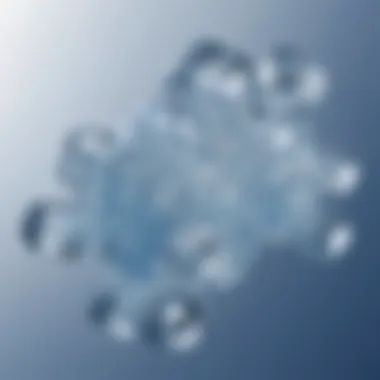Unveiling the Science Behind Ice Melting: An Engaging Project for Young Minds


Science Fun Facts
Ice is an astonishing material that undergoes a remarkable transformation when subjected to higher temperatures. Did you know that ice is less dense than water, which explains why ice cubes float in your drink? This interesting fact showcases the unique properties of ice and raises questions about why it behaves differently from many other substances. Understanding these principles is key to grasping the science behind ice melting.
Discover the Wonders of Science
By delving into the topic of ice melting, we unravel the intricate principles governing this natural occurrence. Through educational videos and animations, young learners can visualize the process of ice transitioning from a solid to a liquid state. Real-life applications of this phenomenon can be seen in cooling systems and changing states of matter, demonstrating the practical significance of understanding ice melting. This exploration sparks curiosity and encourages scientific thinking among our budding Science Buddies.
Science Quiz Time
Interactive quizzes on ice melting can be a fun way to test your knowledge and engage with the topic. From multiple-choice questions probing the effects of temperature on ice to brain teasers challenging your understanding of molecular structure, these quizzes offer an interactive learning experience. Puzzles related to phase changes and thermal energy further enhance comprehension, making learning about ice melting an enjoyable and intellectually stimulating activity. Embracing gamification in learning fosters a dynamic environment for young minds to absorb scientific concepts.
Science Experiment Showcase
Embark on a journey of discovery with hands-on experiments exploring ice melting. Follow step-by-step instructions to conduct experiments that elucidate the factors influencing the rate of ice melting. A detailed materials list guides you in gathering everything from ice cubes to thermometers, ensuring a smooth and safe experimentation process. Safety tips and precautions underscore the importance of handling materials responsibly, nurturing a culture of scientific inquiry founded on caution and precision. Through engaging experiments, the science of ice melting comes to life in a tangible and immersive way, enriching the learning journey of our inquisitive Science Buddies.
Introduction
In the realm of scientific exploration, the phenomenon of ice melting holds a particular fascination. It is a process that captures the imagination and demands understanding. The journey into comprehending ice melting is not merely about frozen water transitioning into liquid form; it is an intricate dance of molecules responding to external stimuli. Through this article, we embark on a quest to decipher the intricacies of this transformation. We will immerse ourselves in the realm of ice, unraveling its mysteries one molecule at a time.
Ice: A Fascinating Substance


Ice, a seemingly simple substance, harbors a complexity that astounds even the most seasoned scientists. At a molecular level, ice showcases a unique arrangement that sets it apart from other materials. Its crystalline structure, with molecules neatly aligned in a hexagonal pattern, contributes to its rigidity and translucence. Understanding the framework of ice provides a gateway to exploring the behavior of solids under varying conditions.
Purpose of the Science Project
The science project centered around ice melting serves a dual purpose in the realm of educational exploration. Firstly, it aims to introduce young minds to the wonders of scientific inquiry through a tangible and engaging experiment. By observing how ice transforms under specific circumstances, participants gain insight into the principles of phase transitions and molecular movement. Secondly, the project encourages critical thinking and hypothesis testing, fostering a scientific mindset among budding enthusiasts. The holistic nature of this endeavor merges theoretical knowledge with practical application, laying a foundation for analytical thinking and experimental design.
Properties of Ice
Ice holds a significant place in the realm of science and everyday life. Understanding the properties of ice is crucial in comprehending the processes related to its melting. The composition, structure, and purity of ice play pivotal roles in how it behaves under various conditions. Ice exhibits a unique crystalline structure that sets it apart from other substances. This structured arrangement at the molecular level influences its physical properties like hardness, transparency, and electrical conductivity. Additionally, the purity of ice, devoid of impurities, ensures uniformity in its composition and influences how it interacts with external factors such as temperature and pressure.
Structure of Ice Molecules
Ice molecules arrange themselves in a hexagonal lattice, forming a solid framework with loosely-held hydrogen molecules. This molecular structure is essential for providing ice its characteristic crystal shape and stability. The arrangement of water molecules in ice dictates its overall stability and rigidity. Understanding this molecular arrangement sheds light on why ice maintains its form at certain temperatures and pressures, offering insights into its behavior during the melting process.
Density and Purity of Ice
The density and purity of ice are key factors contributing to its physical properties and behavior. Ice, in its solid form, is less dense than liquid water, which is a unique trait not commonly observed in other substances. The purity of ice, with minimal impurities, enhances its clarity and crystalline structure. Impurities in ice can affect its melting point and overall stability, making it essential to study the purity levels of ice in scientific experiments to ensure accurate results. Observing the density and purity of ice aids in understanding its behavior during the melting process and under varying environmental conditions.
Factors Affecting Ice Melting
Understanding the factors that influence the melting of ice is intrinsic to grasping the intricate nature of this process. Through meticulous observation and analysis, we can uncover the diverse elements that come into play when ice undergoes the transformation from a solid to a liquid state. This exploration serves as a crucial foundation in the comprehensive study of ice melting, shedding light on the intricate interplay between various external forces and internal properties. By dissecting these factors with a keen eye, we are delving into the underlying mechanisms that govern the behavior of ice when subjected to different conditions.
Temperature Variations


Investigating the impact of temperature fluctuations on ice melting unveils a pivotal aspect of this scientific inquiry. Temperature serves as a potent determinant in altering the state of ice, influencing both the speed and extent of its melting process. By manipulating temperature variables within controlled settings, we can witness firsthand how ice responds to shifts in its thermal environment, leading to nuanced observations and valuable insights. This section will delve deep into the nuanced relationship between temperature and ice melting, elucidating the intricate dynamics at play when heat energy interacts with the molecular structure of ice.
Pressure Influence on Ice
The role of pressure in influencing the behavior of ice during the melting process is a captivating avenue of exploration in this scientific endeavor. Pressure exerts a profound impact on the physical properties of ice, presenting a unique set of challenges and opportunities for experimental study. By applying varying degrees of pressure to ice samples, we can unveil the underlying mechanisms through which pressure modulates the melting behavior of this fascinating substance. This section will unravel the complex interplay between pressure and ice melting, offering a detailed analysis of how external forces shape the transformation of ice under different pressures.
Presence of Impurities
Examining the effects of impurities on ice melting offers a fascinating glimpse into the subtle yet significant variables that influence this phenomenon. The presence of impurities introduces a layer of complexity to the melting process, altering the purity and structure of ice in intriguing ways. By studying the interaction between impurities and ice at a molecular level, we can decipher the mechanisms through which impurities impact the rate and pattern of ice melting. This section will unpack the intricate relationship between impurities and ice, providing a comprehensive outlook on how external elements can modify the fundamental properties of this versatile substance.
Experimental Setup
Ice melting experiments require meticulous planning and precise execution to yield accurate results. The experimental setup serves as the foundation for the entire project, laying the groundwork for a methodical investigation into the melting properties of ice. In this article, the Experimental Setup section plays a pivotal role in guiding young scientists through the process of conducting a well-organized and insightful experiment.
The significance of the Experimental Setup lies in its ability to provide a controlled environment where variables can be observed and manipulated systematically. By outlining the materials needed and the step-by-step procedure to follow, this section equips budding researchers with the tools and knowledge necessary to carry out experiments with precision and scientific integrity.
A fundamental aspect to consider in the Experimental Setup is the selection of appropriate materials. From containers to thermometers, every item must be carefully chosen to ensure accurate measurements and reliable data collection. Moreover, the arrangement of these materials, their placement relative to each other, and the consistency in implementing the procedure are crucial for the success of the experiment.
Furthermore, the Experimental Setup offers young learners a glimpse into the practical application of scientific principles. By engaging in hands-on experimentation, children not only enhance their understanding of the theoretical concepts discussed but also develop crucial critical thinking and problem-solving skills. The process of setting up the experiment enables young minds to cultivate a sense of curiosity and exploration, fostering a passion for scientific inquiry that may shape their future pursuits.
Materials Needed


Selecting the right materials is paramount in ensuring the accuracy and reliability of the ice melting experiment. The Materials Needed section provides a detailed list of equipment and supplies required to conduct the experiment successfully. From basic items such as ice cubes and water to specialized tools like thermometers and timers, each material serves a specific purpose in the investigation.
One of the essential materials for this experiment is a high-quality thermometer capable of measuring small temperature variations accurately. Precise temperature monitoring is crucial for recording the gradual changes in the ice's state and observing the melting process in real-time. Additionally, containers of varying sizes and shapes are necessary to accommodate different experimental conditions and test hypotheses effectively.
Another critical element in the Materials Needed section is the use of distilled water to ensure the purity of the ice samples. Impurities in water can influence the melting rate and introduce variables that may affect the experimental outcomes. By emphasizing the importance of using purified water, this section underscores the significance of controlling external factors that could impact the results.
Moreover, including materials such as magnifying glasses or rulers provides young scientists with the opportunity to make detailed observations and measurements during the experiment. These tools not only enhance the precision of data collection but also encourage children to explore the nuances of ice melting from a scientific perspective, fostering an interactive and enriching learning experience.
Observations and Analysis
Recording the Melting Process
Delving into the specifics of Recording the Melting Process unveils a fascinating journey of tracking the gradual transition of ice from its solid state to a liquid form. As young minds embark on this scientific endeavor, they are tasked with maintaining precise records of empirical data, capturing each incremental change with precision and accuracy. From measuring temperature fluctuations to noting any visual alterations in the ice structure, recording these observations meticulously becomes an indispensable aspect of the experimental process. The meticulous attention to detail in documenting these transformations not only fosters a scientific mindset but also imparts crucial lessons on the significance of systematic record-keeping in scientific investigations.
Interpreting Results
Upon reaching the critical juncture of Interpreting Results, young Science Buddies are presented with a stimulating challenge that requires astute analytical skills and logical reasoning. This pivotal phase of the scientific inquiry involves deciphering the recorded data points to draw meaningful conclusions regarding the ice melting process. By scrutinizing the collected observations through a scientific lens, budding scientists can uncover patterns, trends, and correlations that offer valuable insights into the underlying mechanisms at play. Through the process of interpreting results, young learners are not only encouraged to think critically and draw evidence-based conclusions but are also instilled with the confidence to articulate their findings effectively, thus fostering a holistic understanding of the scientific inquiry process.
Conclusion
Understanding the process of ice melting is essential in various scientific studies. Through this engaging exploration, young minds can grasp the intricacies of temperature fluctuations, pressure impacts, and impurities' presence on ice. The significance of this project lies in its ability to foster critical thinking and experimental skills among our budding scientists. Ice melting serves as a gateway to understanding broader concepts of thermodynamics and material science. By witnessing firsthand how different variables affect the state of ice, children can develop a foundation for future scientific pursuits. Moreover, this project encourages curiosity and a hands-on approach to learning, instilling a lifelong appreciation for scientific inquiry and experimentation. It demonstrates that even seemingly simple processes like ice melting contain valuable lessons and insights waiting to be uncovered.
Key Learnings
Throughout this science project, children will gain a deep understanding of the properties of ice, including its molecular structure, density, and purity. They will learn how external factors such as temperature and pressure influence the melting process, broadening their knowledge of thermodynamics and phase transitions. Moreover, by recording and analyzing the ice melting process, young scientists will develop essential observational and analytical skills. This project fosters an environment where critical thinking and data interpretation are key components of scientific exploration. In essence, the key learnings from this project go beyond ice melting; they lay the groundwork for a scientific mindset, encouraging curiosity, attention to detail, and a methodical approach to problem-solving.
Future Experiments
As young scientists complete this project, they are poised to embark on future experiments building upon their newfound knowledge. One promising direction is exploring the impact of different types of impurities on the ice melting process. By introducing various substances into the ice samples, children can observe how impurities alter the rate of melting, offering insights into real-world applications of this phenomenon. Additionally, future experiments could delve into the interaction between ice melting and environmental factors, such as humidity levels or air pressure. Understanding how these variables interact with ice melting can lead to a more comprehensive comprehension of thermodynamic processes in natural environments. By encouraging young scientists to think creatively and explore new avenues of inquiry, this project sets the stage for a lifetime of scientific discovery and innovation.







